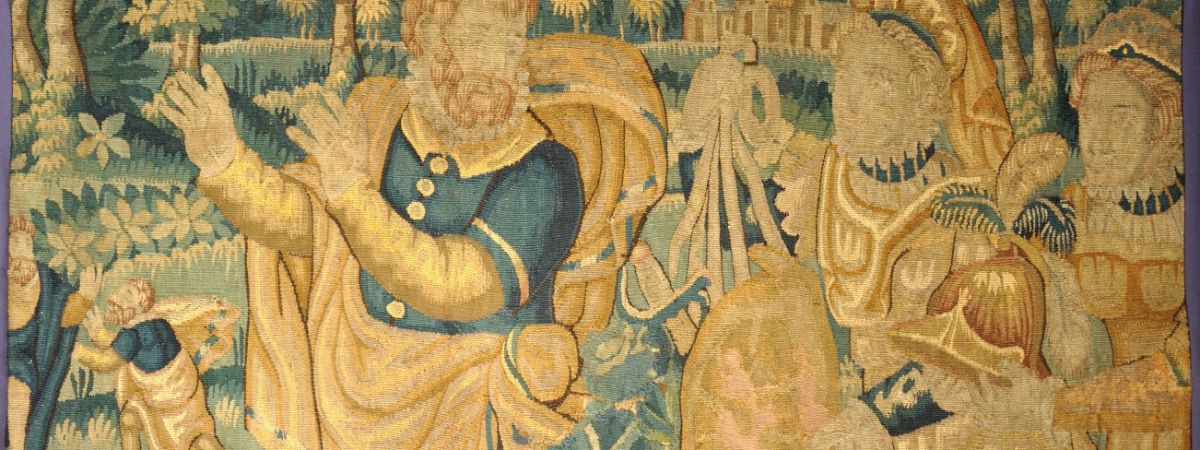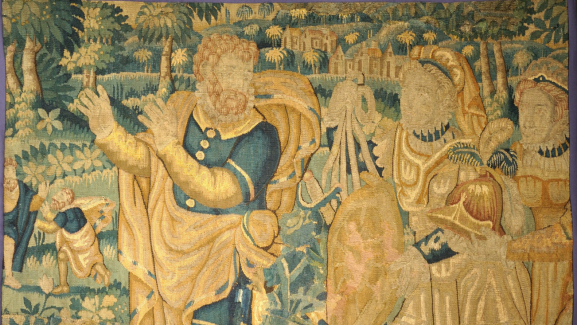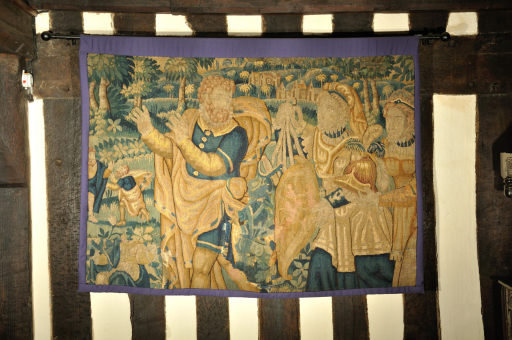Object of the Month

Share
The Achilles Tapestry
For October, the object of the month is our early modern Flemish tapestry that depicts the Greek hero Achilles in the Trojan War.

Fig.1. The Achilles Tapestry
Tudors fascination with Antiquity
During the sixteenth century, the gap between the rich and the poor was larger than ever. As a result of the hierarchical nature of Tudor society, the wealthy had opportunities to access resources that others did not. One of these resources was classical literature from Ancient Greece and Rome. Interest in the antiquity period was on the rise after the discovery of Pompeii in the late 1500s with new findings of statues, mythical figures, and evidence of the way of life in ancient times. Knowledge of ancient civilisations was previously lost until the excavation of Pompeii.
With the rediscovery of Pompeii brought about a renewed fascination of Greek and Roman myths in the sixteenth century. One such myth that captured the imaginations of wealthy Tudors was the story of the Trojan War. Homers Iliad was a prominent source for the stories of the Trojan War focused on the demi-god warrior Achilles. Filled with rich tales of destiny, valour and glorious battles the Trojan War became an ideal subject for Tudor decor. In particular, Tudors depicted the events of the mythical War in cravings and tapestries.
Selly Manors Achilles Tapestry
Our Achilles tapestry is one such example. It hangs on the wall in Selly Manor's Hall. The tapestry would have originated from a wealthy Tudor mansion before Lawrence Cadbury added it to his collection in 1936. The colours of the fabric have faded now from their original splendour. The tapestry itself was divided into two sections before it was purchased from a prominent antique dealer Oliver Baker. The other half can be found at Packwood House, owned by the National Trust. This section was most likely attached from Selly Manor's right half with two women looking in the direction of Achilles.

Fig.2. Achilles Tapestry in Selly Manor's Hall

Fig. 3 The other fragment of the tapestry that is located at Packwood house
The Story of Achilles

Fig.4. Achilles in battle depicted on pottery
Achilles was a popular figure in Greek mythology, he was the son of a goddess and a mortal which made him a powerful demigod. When he was a baby his mother, Thetis, dipped him in the river Styx thus granting him invulnerability except for his heel where she held him. This is where the term Achilles Heel comes from.
Homer's Iliad recorded a version of the Trojan War and Achilles' story that had previously been passed down orally; it was only when Homer decided to write it down that we had permanent records of it. When King Agamemnon kidnaps his wife Brises, he dishonours Achilles, the most powerful warrior in his army. For the rest of the story, Achilles sits in his rage and refuses to fight. As a result, the war becomes the Gods' primary source of entertainment because they are free to stop and restart the war at their leisure.
Later in the Iliad, Achilles' mother presents him with custom-made armour from Hephaestus, the blacksmith god, which convinces him to join the battle. After his close companion, Patroclus is killed on the battlefield in Achilles place. Achilles returns to fight in the war and the Iliad ends with Achilles killing his enemy, Hector, in revenge for his friend's death.
Where does our tapestry originate from?
It is possible that the tapestry depicted one or both of these elements of the story, and it was most likely part of a series of tapestries depicting various scenes from the Iliad. Both the Selly Manor and Packwood House tapestries were created in the southern Dutch city of Oudenaarde. Selly Manors Achilles tapestry showcases many of the distinctive elements of Oudenaarde tapestries with its rich earthy colours, background of greenery and the tapestrys focus on Greco-Roman mythology.
From the fifteenth century to the eighteenth century, the Dutch city of Oudenaarde was a focal point of tapestry craftsmanship in Europe. Tapestries produced in Flemish cities, such as Brussels, Antwerp and Oudenaarde at this time were renowned for their beauty and quality. Though, Oudenaardes tapestry industry was notable for the sere volume of ornate tapestries created there. by the sixteenth century, more than half of the city's population was employed in the tapestry trade. Oudenaarde tapestries were a desirable commodity for European courts and country nobles.
- Chloe, Volunteer